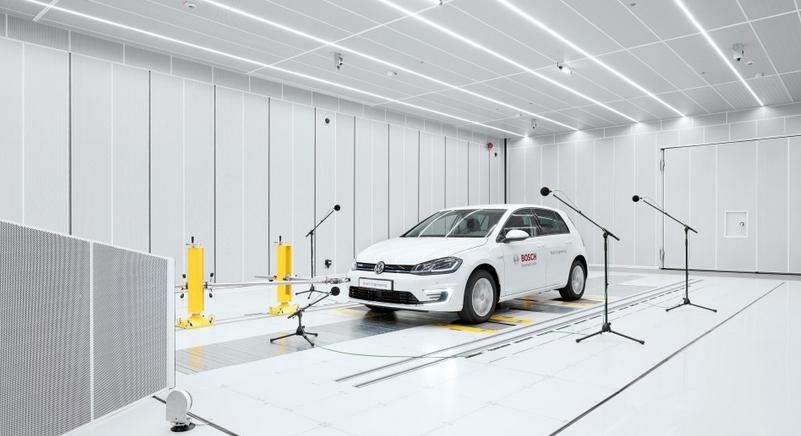
Bosch Engineering opens vehicle acoustics test centre
Vehicle acoustics are steadily gaining traction as a quality criterion in today’s cars.
When a vehicle is in motion, audible or perceptible vibrations emanating from individual components can cause annoying automotive noise conveyed by the vehicle’s structure and rendered as airborne sound.
Acoustics experts refer to this phenomenon as NVH, which is short for noise, vibration, harshness.
Minimising noise with NVH analyses is a fixture of automotive engineering. “The increasing shortening of development cycles requires an ideal integration of acoustic optimisation into existing development processes,” says Jörg Vetter, Senior Manager, New Calibration Services & Products at Bosch Engineering.
With a new acoustics test centre in Abstatt, the company is setting the stage for an efficient development process to improve NVH.
It will enable development times to be reduced still further while enhancing vehicle acoustics.
Acoustics are a major issue in automotive engineering. Firstly, government regulations for vehicle registration set out limits for external noise levels.
Secondly, car buyers and owners expect less vibration and noise and a smoother, quieter ride.
New electric and hybrid drives also present considerable and often very specific challenges for acoustics experts seeking to improve NVH.
Acoustics has to be included early on in the development process, when new models are still on the drawing board.
Bosch Engineering supports automakers’ efforts to improve NVH with a holistic engineering approach focused on optimising the vehicle.
“In acoustics analysis, we take advantage of the synergies resulting from the close collaboration within Bosch Engineering and with the Bosch Group’s acoustical engineers,” says Jörg Vetter.
The company offers customers a comprehensive service package spanning the entire product development chain for a new vehicle.
Providing advice in the design phase and support in the development phase, it also helps customers to continue improving their vehicles’ NVH behavior.
Engineers often test-drive cars on public roads or private test tracks to investigate their acoustics.
The problem with open-road tests is that external factors such as ambient noise, weather conditions or the driver’s profile may skew the measured results.
This is why test series are often long and tedious, with results that are hardly reproducible.
Bosch Engineering has created an ideal environment for assessing vehicles’ NVH performance in its state-of-the-art acoustics test centre in Abstatt.
With a soundproof hemi-anechoic chamber isolated from the outside world, it provides a far more efficient means of testing and comparing new or modified components and calibrations under uniform conditions and with a view to their impact on the overall vehicle.
This reduces the cost and time involved in engineering new cars’ acoustics and optimising legacy vehicles’ acoustics.
“In our test centre, we can quickly detect noise sources that impair driving comfort and develop countermeasures together with our customers,” notes Jörg Vetter.
Tailor-made and reproducible, the development centre’s measurement, analysis and evaluation procedures serve to rapidly assess and optimise acoustical phenomena.
The centrepiece of test centre is a specially equipped chassis dynamometer. It is suitable for vehicles with a combustion engine, a hybrid drive, or an electric drive, and for all-wheel, front-wheel and rear-wheel drivetrains.
The four independently controllable rollers deliver 150 kW each for speeds ranging up to 250 km/h. They can simulate various wheel torques, for example of a cornering car, and wheel loads.
A well-insulated test cabin and silent rollers reduce background noise to a minimum so engineers can measure even very low sound pressure levels. This is a great competitive advantage, especially for testing electric vehicles.
Without a combustion engine to mask automotive noise, the acoustics of powertrain peripherals are far more perceptible. The test bench design even includes specific monitoring functions for future hydrogen vehicles.
The lab, sound studio and chassis dynamometer are in separate rooms. The lab is equipped with precision instrumentation for measuring vibration and sound pressure levels and conducting modal analyses to break down dynamic NVH behaviour.
The sound studio features high-tech equipment including headphones for binaural reproduction and a 13-speaker array for higher-order Ambisonics reproduction.
This setup enables engineers to compare diverse components’ acoustic behaviour in the virtual realm without having to install them in the actual vehicle.
They can also switch between two NVH scenarios at the push of a button for A/B comparisons.
Upstream from the testing area is an assembly hall. It serves as a staging area to prep vehicles for tests.
With its capacity for preconditioning up to ten cars simultaneously, it provides an efficient means of executing even very extensive sets of measurements and achieving reproducible results.


